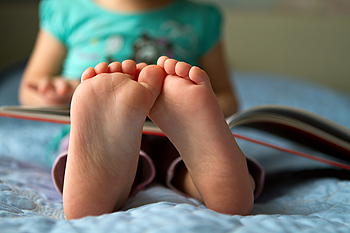
It is never normal for a child to experience pain in his or her feet. Foot pain that lasts more than a few days and limits a child’s ability to walk should be examined by a podiatrist. Many adult foot ailments originate in childhood and may be present at birth. Common foot issues that are experienced by children are pediatric flat foot, Sever’s disease, ingrown toenails, and plantar warts.
A child’s foot grows rapidly during the first year, allowing it to reach almost half of their adult foot size. Consequently, foot specialists consider the first year to be the most crucial point in the foot development process. There are ways you can help ensure that your child’s foot develops properly. One way is to carefully look at your baby’s feet. If you notice any deformities, you should immediately seek professional care. You should also loosely cover your child’s foot, since tight coverings may prevent movement and inhibit normal development. Another tip is to change the baby’s positioning throughout the day. If your baby lies down in one spot for too long, it may put an excess amount of strain on the feet and legs.
It is best that you try not to force a child to start walking. Children will begin to walk when they are both physically and emotionally capable to do so. You should also avoid comparing your child’s walking progress with other children because the age range for independent walking may range. When your child’s feet begin to develop, you may need to change both their shoe and sock size every few months to allow room for their feet to grow.
Kids are sometimes prone to splinters, cuts, and severe injuries because they tend to walk around barefoot. This also makes them more susceptible to developing plantar warts which is a condition caused by a virus that invades the sole of the foot through breaks in the skin. These ailments can be avoided by making sure your child wears shoes in unsanitary environments. You should also wash any minor cuts or scrapes on your child’s feet. It is a myth that exposure to fresh air will heal injuries; fresh air will only expose your child’s cuts to germs.
As a parent, you should ensure that your child’s feet are developing properly and are being properly maintained. Consequently, it is important that you perform routine inspections on his or her feet to detect any injuries or deformities in their early stages. Early detection and treatment will help to ensure that your child does not develop any serious foot conditions.
 Babies’ feet are considerably more flexible than the feet of adults. This is because their foot bones have not fully developed; damage to the feet can therefore occur easily to children’s feet when compared to adult feet. Research has indicated it is not necessary for young children to wear shoes while indoors. The toes will become stronger as they grasp the floor, and this will help the feet naturally develop. When shoes are eventually worn, it is helpful to measure your child's feet every three months until they are approximately three years of age. This can ensure that there is enough room in the shoes for the toes to move freely. Research has indicated that many babies are born with flat feet, and this is generally outgrown by the age of six or seven. If you notice your child is walking with their toes pointed inward or outward, it is suggested to speak to a podiatrist who can determine if this is due to any underlying foot conditions.
Babies’ feet are considerably more flexible than the feet of adults. This is because their foot bones have not fully developed; damage to the feet can therefore occur easily to children’s feet when compared to adult feet. Research has indicated it is not necessary for young children to wear shoes while indoors. The toes will become stronger as they grasp the floor, and this will help the feet naturally develop. When shoes are eventually worn, it is helpful to measure your child's feet every three months until they are approximately three years of age. This can ensure that there is enough room in the shoes for the toes to move freely. Research has indicated that many babies are born with flat feet, and this is generally outgrown by the age of six or seven. If you notice your child is walking with their toes pointed inward or outward, it is suggested to speak to a podiatrist who can determine if this is due to any underlying foot conditions.
The health of a child’s feet is vital to their overall well-being. If you have any questions regarding foot health, contact Dr. Alan J. Spector of Shore Podiatry. Our doctor can provide the care you need to keep you pain-free and on your feet.
Tips for Keeping Children's Feet Healthy
If you have any questions, please feel free to contact our office located in Point Pleasant, NJ . We offer the newest diagnostic and treatment technologies for all your foot care needs.